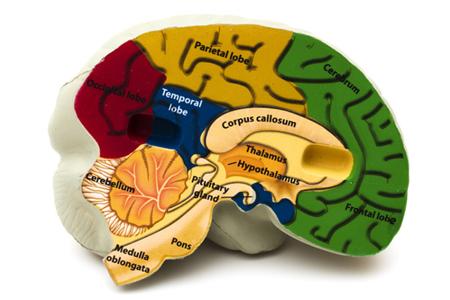I predict that when we find the neural mechanism underlying PCT, it will be mostly in the cerebellum. As did Bill Powers, of course.
Ted

···
Featured Research
from universities, journals, and other organizations
Unexpectedly speedy expansion of human, ape cerebellum
Date:
October 2, 2014
Source:
Cell Press
Summary:
A new study could rewrite the story of ape and human brain evolution. While the neocortex of the brain
has been called ‘the crowning achievement of evolution and the biological substrate of human mental prowess,’ newly reported evolutionary rate comparisons show that the cerebellum expanded up to six times faster than anticipated throughout the evolution of
apes, including humans.
Share This
·
Email
to a friend
·
Facebook
·
Twitter
·
LinkedIn
·
Google+
·
Print this
page
Model of human brain (stock image).
Credit: © Karen Roach / Fotolia
[Click to enlarge image]
A new study published in the Cell Press journal Current Biology on
October 2 could rewrite the story of ape and human brain evolution. While the neocortex of the brain has been called “the crowning achievement of evolution and the biological substrate of human mental prowess,” newly reported evolutionary rate comparisons
show that the cerebellum expanded up to six times faster than anticipated throughout the evolution of apes, including humans.
The findings suggest that technical intelligence was likely at least as important as social intelligence in human cognitive evolution, the researchers say.
“Our results highlight a previously unappreciated role of the cerebellum in ape and human brain evolution that has the potential to refocus researchers’ thinking about how and
why the brains in these species have become distinct and to shift attention away from an almost exclusive focus on the neocortex as the seat of our humanity,” says Robert Barton of Durham University in the United Kingdom.
The cerebellum had been seen primarily as a brain region involved in movement control, adds Chris Venditti of the University of Reading. But more recent evidence has begun to
suggest that the cerebellum has a broader range of functions. The cerebellum also contains an intriguingly large number of densely packed neurons.
“In humans, the cerebellum contains about 70 billion neurons – four times more than in the neocortex,” Barton says. “Nobody really knows what all these neurons are for, but they
must be doing something important.”
The neocortex had gotten most of the attention in part because it is such a large structure to begin with. As a result, in looking at variation in the size of various brain regions,
the neocortex appeared to show the most expansion. But much of that increase in size could be explained away by the size of the animal as a whole. Sperm whales have a neocortex that is proportionally larger than that of humans, for example.
By using a comparative method that controlled for those differences in the way the two brain structures correlate, Barton and Venditti uncovered a striking pattern: both nonhuman
apes and humans depart from the otherwise tight correlation in size between the cerebellum and neocortex found across other primates due to relatively rapid evolutionary expansion of the cerebellum.
Barton and Venditti say that the cerebellum seems to be particularly involved in the temporal organization of complex behavioral sequences, such as those involved in making and
using tools, for instance. Interestingly, evidence is now emerging for a critical role of the cerebellum in language, too.
While plenty of work remains, the new study establishes the cerebellum as “a new frontier for investigations into the neural basis of advanced cognitive abilities,” the researchers
say.
Story Source:
The above story is based on materials provided
by Cell Press. * Note:
Materials may be edited for content and length.*
Journal Reference:
Barton et al. ** Rapid evolution of the cerebellum
in humans and other great apes**. Current Biology, 2014 DOI: 10.1016/j.cub.2014.08.056
Cite This Page:
